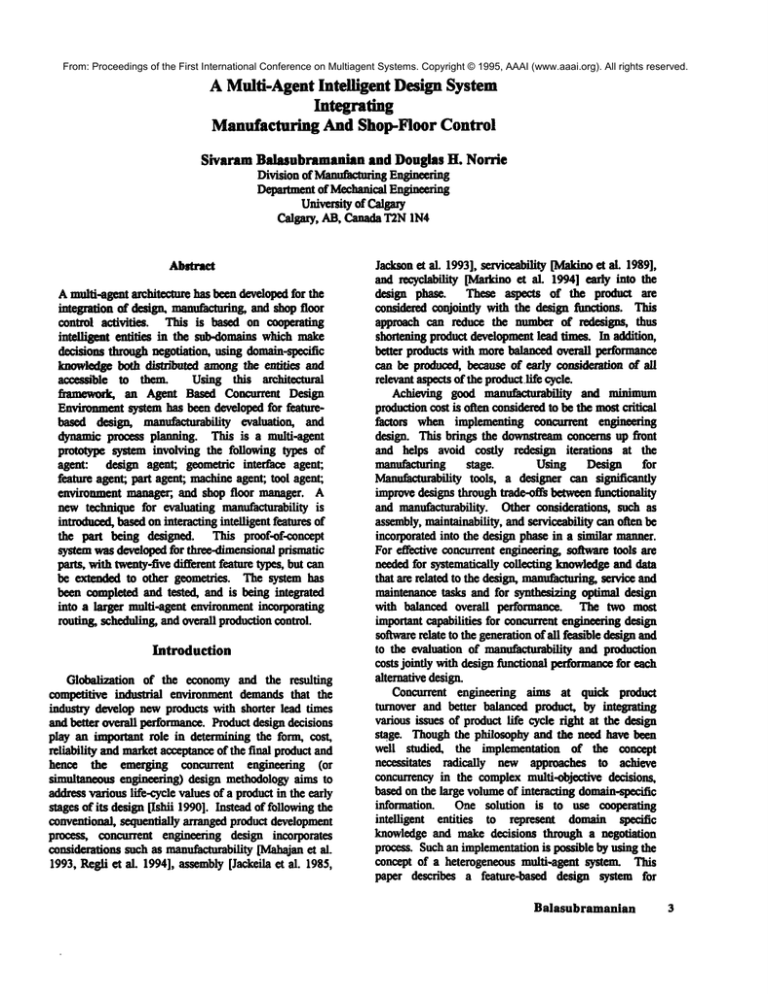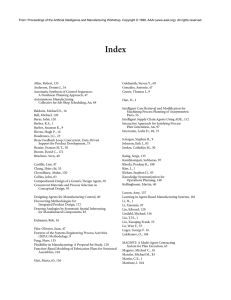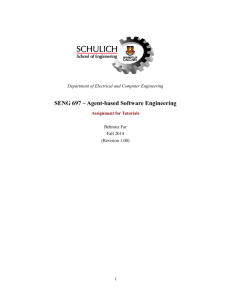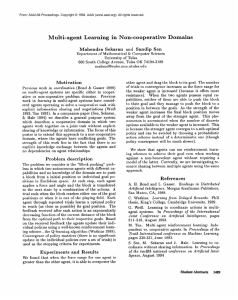
From: Proceedings of the First International Conference on Multiagent Systems. Copyright © 1995, AAAI (www.aaai.org). All rights reserved.
A Multi-AgentIntelligent Design System
Integrating
ManufacturingAndShop-Floor Control
Sivaram
Bsll ubramanian
andDouglasH. Norrie
Division of ManufaclnringEngineering
Depamnentof Mechanical
Engineering
University of Calgely
Calgary, AB, C.=nadn T2NIN4
Abm’aet
A multi-agnnt architectnre has been developedfor the
integration of design, riming, and shop floor
control activities. This is based on cooperating
intellismt entities in the sub-domain~which make
decisions through negotiation, using domain-specific
knowledgeboth distributed amongthe entities and
ao~ssible to them. Using this archRecmral
framework, an Agent Based Coty~’rent Design
Environmentsystem has been developed for featarebased design, manufacturability evaluation, and
dypnmlc process planning. This is a multi-agent
prototype system involving the following types of
agent: design agent; geometric interface agent;
feature agent; part agem;machineagent; tool agent;
environment manager; and shop floor manager. A
new technique for evaluating manufacturability is
introduced,basedon interacting intelligent features of
the part being designed. This proof-of-concept
systemwas developedfor three-dimensional prismatic
parts, with twenty-fivedifferent feature types, but can
be extended to other geometries. The system has
been completed and tested, and is being integrated
into a larger multi-agent environmentincorporating
muting,sehecbding, and overall productioncontrol.
Introduction
Glob~liTAtion of the economy and the resulting
competitive industrial envimment demands that the
indusuy develop new products with shorter lead times
and better overall performance.Product design decisions
play an important role in determining the form, cost,
reliability and marketacceptanceof the final product and
hence the emerging concurrent engineering (or
simultaneous engineering) design methodologyalms to
address various life-cycle values of a product
in the early
stages of its design [Ishii 1990]. Instead of followingthe
conventional, sequentially arranged product development
process, concurrent engmeoring design incorporates
considerations such as mannfacturabifity [Mabajanet al.
1993, Regii et ul. 1994], assembly[Jackeila et al. 1985,
Jacksonet al. 1993],serviceability [’Makinnet ul. 1989],
and reo/d~ility [Markino et al. 1994] early into the
design phase. These aspects of the product are
considered conjointly with the design functions. This
approach can reduce the number of redesigns, thus
shorteningproduct developmentlead times. In addition,
better products with moretml~nced overall performance
be produced, because of early consideration of all
relevant aspectsof the product.life cycle.
Achieving good manufactarab~ty and minimum
productioncost is often consideredto be the mostcritical
factors when implementing concurrent engineering
design. This brings the downstreamconcerns up front
and helps avoid costly redesign iterations at the
manufacturing
stage.
Using Design for
ManufLetumbilitytools, a designer can significantly
improvedesigns through trade-offs betweenfunctionality
and manufacturability. Other considerations, such as
assembly,maintainability, and serviceability can often he
incorporated into the design phase in a similar manner.
For effective concurrent engineering, software tools are
neededfor systematically collecting knowledgeand data
that are related to the design, manufacturing,service and
maintenance tasks and for synthesizing optimal design
with b.qlnnced overall perform*nee. The two most
intportant capabilities for concurrentengineeringdesign
softwarerelate to the generationof all feasible designand
to the evaluation
of ~ility
and production
costs jointly with design functional performancefor each
alternative design.
Concurrent engineering aims at quick product
turnover and better b,qlanced product, by integrating
various issues of product life cycle right at the design
stage. Thoughthe philosophy and the need have been
well studied, the implementation of the concept
necessitates radically new approaches to ac~hieve
concurrency in the complexmulti-objective decisions,
based on the large volumeof interacting domain-specific
information. One solution is to use cooperating
intelligent entities to represent domain specific
knowledge and make decisions through a negotiation
process. Suchan implementationis possible by using the
concept of a heterogeneous multi-agent system. This
paper describes a feature-based design system for
Balasubramanian
3
From: Proceedings of the First International Conference on Multiagent Systems. Copyright © 1995, AAAI (www.aaai.org). All rights reserved.
prismatic components, implemented within the
frameworkof multi-ngent based concurrent engineering
design. The multi-ngent architecture for integrating
design, manufacturing and shop-floor control is also
described and the implementationissues associated with
thig i~c~l 81~ analyzed.
Related
Work on Feature
Based Dmign
Featum-bueddesign is central to the Agent Based
Concurrent Design Environment developed. The major
features of several key existing feature-based design
systemsare therefore briefly reviewed.
TheFit3t-Cut project is a feature-beseddesign system
in which individual features and their corresponding
procc~ plans are combined to create a part and
manufactmingplan concurrently [Cntkoskyet al. 1988].
The Next-Cut feature-based design system was developed
to work on designs from wore than one level of detail
and across multiple views while maintaining consistency
of part representation [Cutkoskyet al. 1992].
The Ar/zoua State University Features Testbed is a
system for designing, documentingand evaluating parts
and is or~nized into a shell for product definition and
another for mappingand applications [Shah and Rogers
1989]. The Feature Modeling Shell includes a form
feature modeleras well as other modelersfor tolerances,
materials, etc. Each modelercan be used in setup mode
to create specific features and feature knowledge.These
feature libraries can then be used to create part models.
The Qtfick Turnaround Cell System (QTC)
[Anderson and Chang 1990] combines a feature-based
design system with automatic process planning. In this
system, the features are related to machiningoperations,
but do not correspond on a one to one basis with
~rtannfafUMing f-e~ltuge$. CADETS
is a feature based
design system incorporating manofact~ngconstraints
[Wright and I-I~nam 1989].
For products designod in an external location the
sequential process of feature recognition, process
planning and scheduling maybe quite appropriate and
one such approachis given in [Cmetat. 19941.
A general architecture for the design with features
concgpt is given in [Dixon 1988]. A comprehensive
review of early research in mechanical engineering
design including features and feature baseddesign can be
found in Finger and Dixon [1989a, 1989b]. A more
recent snmmary
of research in feature based design is
given by ~lomom[1993].
The foUowing
conclusions can be drawn from the
literature review.Feature identification and definition is
neeemmyto adequately represent tolerancing and other
manufacturingrelated information. There are two basic
approaches: recognize (identify) appropriate features
after desitmiQg with geometric elements or to design
from the beginning using features. Despite the
4
ICMAS-95
mnsiderable improvement in feature recognition
techniques, they do not producea sufficiently complete
set of data and certain mam~re]aged information
has to comefrom other sources, thus makingcomplete
automationdifficult. Moreover,feature recognition is a
seqt~tial process and besga~mmmentevaluation of
features for mamffacturability is not feasible. Feature
based d~_igndoes not have these disadvantages, but can
have the problem of having too manyfeatmmto easily
wanage. User configurable features provide a feasible
solution to this problem. However, fea~ design
representatioas are non-uniqne, depending on the
selection and use of features. Concummt
automation is
possible with feature based design and hence, holds more
promisefor concurrent engineeringdesign.
The initial approaches to concurrent engineering
design used a centrafi~l knowledgebmc. A disUributed
approachis advantageoussince infommtionpertaining to
~in.¢ Call be separately and better organized
and nmlti-objecfive decisiom
canbe achieved
through
the cooperating entities aeee~ngthese Imowledgebases.
Such an approach is fe~ble through the concept of
betemgeneonsmulti-agent ~tenm.
In recent years, several distributed agent approaches
to concurrcmengineering have been reported, including
the large-granularity Palo Alto Collaborative Testbod
(PACT)[Cutknsy et al. 1993] in which existing design
and other systems were ’wrapped’to form agents and the
finer-granularity Designworld system[Genesereth1991]
in whichprocesses were implementedas agents.
A Multi-Agent
Framework for Concurrent
Engineering
Materials and shop floor resources greatly affect the
man~ity
analysis.
A design
may be
manufacturshleunder one set of shopfloor resources, but
not another. Likewise, the stock materials from which
the part will be manufacturedcan impact the numberof
stepsrequired,andhencethe cost of the design. Further,
the schedule of shop floor resources wiU have a
significant impact on the process plan to be used and
hencothe cost of design.
Ideally, a productdesigner should be awareof all the
technical constraints (material~processes, tools, etc.)
and shop floor consWaints(routing,
scheduling, etc.).
But with the yew large amountof infommtitminvolved,
a designer often needs the assistance of other domain
experts. Thin process of information exchange, whether
it be sequential or concurrent, can be very time
consuming.Onesolution to this ’designer’s dilemma’is
having intelligent interacting entities whichcan supply
domain-specific information to validate the product
design, without any input fromthe designer.
The hetemgencous multi-agent architecture which
has been developedat TheUniversity of Calgary involves
From: Proceedings of the First International Conference on Multiagent Systems. Copyright © 1995, AAAI (www.aaai.org). All rights reserved.
Dedsn
Feature
Agmt
FigureI l}esign Interactions
intelligent interacting agents whichcollectively possess
the necemuyknowledge about ,-~-ufamarability and
shop floor control for conconent product design and
evaluation. These .agents dynamically access, transfer,
and evaluate muchof the lower level design information,
transparently to the designer. Figure I shows typical
design intem~omwithin this frameworkamongthe key
agents involved.
In this architecture, the shop floor control agent
imposes an ’Ad~fiVe hierarchy’ over the shop floor
resom~agents and.keeps track of the system state. The
adaptive hierarchy reflects the ability of the shopfloor
control
agenttomaintain multiple virtual groupings of
resources (machine, tool, material handling equipment,
etc.), to accommodate the current ~ut policies
and system status. Such an adaptive hierarchy can help
imposeproduct priorities, changesin due dates and cope
with internal distnrlmnces (machine breakdown, tool
breakages,etc.), by reassiL, ningresourceagents.
The. design feature agents help to define and evaluate
rite local geometric, tolerance and other manufacturing
specifications of the product, concurrently. Eachtype of
feature has ’its ownfeature class, and each individual
feature has its own fea~-e agent. The concept of
intelfigent feauumwas introduced by Mowchenko
et al.
[1994] in eadier work on multi-agent based intelligent
design. The inventory agent helps in addressing
concerns about material requirements for manufacturing
the product. The machineand tool agents evaluate the
manufactmability
and produce process plans
incrememally, as the design progresses. All of these
agents are knowledgeableabout their own domainsand
can advise other agents about violatlom or alternative
solutions in their dom~in~
uponrequest.
In this multi-agent design environment, the design
agent carries out the design task oblivious to the
constraints and restrictions of other related domains.
Like any other agent, the design agent can request
information from another agent about a violation or
alternative solution in the latter domain.He or she
define variations and let the other agents decide on
consequentoutcomes.In all cases, the ideal is to arrive
at multi-objective decision(s) concurrently, through the
cooperative negotiation amongdifferent agents.
The architecture
can be readily extended to
incorporate other life cycle concerns such as assembly,
service, recyclingetc. by the addition of suitable agents.
Thusthe architecture is generic in mture. The ability to
address design issues con~ntrreutly with the dynamicsof
shop-flooris a noveltywith this apprmc,h.
The Agent Based Concurrent Design Environment
(ABCDE)
described below is a proof of concept prototype
system implemented to demonstrate this muiti-agent
based conmrrent engineering framework.
Implementation
of ABCDE
The Agent Based Concurrent Design Envimnmeut
has been implemented using an object oriented
programming
language (C++), whichfacilitated efficient
coding through object oriellted mechanismssuch as
parametrized types, multiple inheritance, and dynamic
Balasubramanian
$
From: Proceedings of the First International Conference on Multiagent Systems. Copyright © 1995, AAAI (www.aaai.org). All rights reserved.
N
V
I
R
O
N
M
E
N
T
S
H
O
P
F
L
O
O
R
M
A
N
A
G
E
R
M
A
N
A
O
E
R
Fig. 2 ABCDE
Ageat Architecture
binding. The Advanced Modeling Extension and
Application Programming Interface of Autodesk’s
AutoCAD
were used to implement the geometric user
front end, and for graphic display and pmnipulation.This
was to provide a popular, low cost geomelxicfront end,
with readily avnil#thle and provendmedng
aids.
Being an agent based system, the organization of
ABCDE
i~ m~ldnr. The overall system ai~hite~ure of
ABCDE
is shown in Figure 2. This multi-agent system
is heterogeneous in nature involving the following
different agent types: design agent, geomeuic
interface
ngent, feamm<ypeagents, inventory agent, machine
agent, tool agent and part agent.
Thedesign
agent is the
humandesign export. The geometric interface agent acts
asa buffer to translate
informationbetweenthe geometric
front end and other agents, and helps in separating low
level appli~ion-qmdfic coding.
As noted earlier, the feature types are for threedimensional prismatic component&in this version.
There is a feature agent clam for evezy, feature type.
Imposingstrict non-degenerativedesign features with a
one-to-one relationship to manufacturingfeatures could
be very mstri~ive from the designer’s perspective.
Hence, the features are allowed to degenerate and the
feature agents can detect degeneracy and resolve it
appropriately. Consistency checking is carried out and
resolution takes place, whenevera feature gets modified
dire~dy or indirectly. The major degenerate features
types included
arestep, pocket, rectangular slot,
U-slot,
V-slot, clove tail slot, T-slot, flat bottomhole, taper
bottom
hole,counter
sink,
counter
bore,wedge,
thread,
6
ICMAS-9$
cbsmfcrand fillet. There are a total of twenty-five nondegematefeature types, inter--,y. The featere agents
evaluate local manufeffmmbifitywhenthey are first
~reated or whenever they get modified directly or
indire~dy. Local man~ility evaluation iacludes
accessibility, stability, and tolmanm-sm~tco
finish
compatibility,etc.
The inventory agent keeps tracks of the available
stock materials and their s lmp~ ~nd advises about
altemativo stoc~ sizes that muldbe meal, if enonghstock
of requested size is not available. TI~ hellm the design
agent in evaluating the stock-met olXions and in
materials requirementsplanning.
Every machineon the shop-floor b mpresontedby an
autonomous machine agent. This machine agent has
knowledge about its machine’s physical and process
capabilities,
probable tooling and schedule. Upon
request, the machineagent explo~the _po~__’bilityof its
machine contributing towards the manufa~emof a
feature and then evaluates ultemativo proccasmthat can
be used within its calmbilities. If a sali~a~ry process is
found, the nmchineagent attctimm for tools relevant to
the process and chooses one based on optimum
perfornmnco-cost combination. If the machine agent
cannot
meet
thetoleran~
specification,
it will try tosubconuact
themachining
requimatem.
Italsochecks
for
global mncorm
suchas ao~sibility,
stability,
~nd due
date. Anyanomalyor failure, unnmolvedor detected in
the above process is promptly notified to the design
agent.
From: Proceedings of the First International Conference on Multiagent Systems. Copyright © 1995, AAAI (www.aaai.org). All rights reserved.
Every tool in the shop-floor is represented by an
autonomoustool ngenL The tool agent Ires knowledge
about its shape, schedule and toleran~ capabilities in
combination with a particular
machine and work
mmmial,under certain operating parameterx This is
he.t~ in aummat~toot and opermingpammmr
selection for a particular process request from a given
machine. As was noted cariier, the selectiun preoess is
a~._,~d
~ bidding
by the int©~l machine
a~L
The part
A Design
agent
dynanfically
updates
knowledge, as the design prngreme~The product data
inclmim the geometric and ~ specifications
while the product knowledgeincludes the conditions
under which a particular specification was accepted as
mamffnctumble.This helps in consistency validation
both when the conditions change and also when the
productis to be modifiedlater on in its life.
There are two agent coordinators, namely the
mann~er alld
the shop-floor
Session
withABCDE
and w~intain¢
itself as the t~xmitoty
for bothproduct
dataand
envigoBlnl~tt
be manufactomble. The manufacturing knowledge
implemented in the system has been collected and
synthesized from a widevariety of somces.
Being a proof of concept prototype application, the
numberof features and the degree of intelligence
by the system is limited for a real world problem.
Howeverthe architecture is modular and generic, and
henceadditional features can he incorporatedover time.
ma~q~l’,
and
all of the other agents interact with each other through
them. The presence of agent coordinators helps in
eliminating
~ communication
among agents
whichisirrelevant
tothecurrent
m~andinthedynamic
restmctu~g of agent groups (e.g. upon machine/tool
breakdown or addition). The environment manager
merely acts as a message redirector and possesses no
extra knowledgeof its own.
The shop floor w~nngerplays a vital part in shop
floor control, in addition to its function and message
redirection. It helps maintain virtual groupingsof shop
floor remurc~s to accommodate current wnnngement
policies and system status. It also helps in imposing
hierarchy within a group as required. For example, it
broadcasts about a feature requirement only to those
machine agents that are in the highest level of the
hierarchy (primmyproce~ machines, such as milling or
drilling). These machineagents may then request the
shop floor ~nagerto sub-contract to machinesat a
lowerlevel in the hierarchy(secondaryor tertiary process
machines, such as grinding, honing, or lapping). Apart
from avoiding unnecessmycommunicationamongagents
irrelevant for the present task, this also helps in the
machineagents remaining independent of system status
(i.e.
they
need
not
keep
track
of
additiun/deletion/regrouping of resources). The shop
floor nmn~ralso resolves the bidding process, in the
case of morethan one bidder. It also notifies the design
agent if either noneor only incompletespecifications can
be satisfied.
A primmy
concept in implementation was to make
the system a design advisory aid and not to place any
restrictions on conflict resolution. This meansthat the
designer is not foreed to clear up any or all unresolved
issues before proceeding
further,but if he does resolve all
issues before proceedingso the product is guaranteedto
The designer can start the process by using a
preproeessedblank geometry.It shouldhe notedt lint this
blank geometry may only be tentative and can be
changedin the midst of the design process, if needarises.
The inventory agent will automatically check the
available stock sizes and shapes for the required quantity
and advise the design agent accordingly. The design
agent mayevaluate available stock-oost options or may
request the purchase departmentfor stock procurement,
or maypostponetiffs discussion until later, in whichcase
the processrepeats at a later stage.
The design agent (designer) selects a feature for the
part, which requests the environment mnnRger to
instantiate this partio~tAr feature type on the blank The
managerredirects the request to the appropriate feature
agent. Next, the feature agent will request the design
agent, through the manager,for dimensional, lucationai,
tolerance and other m~mufa~uring
related information.
After collecting enoughinforw~don,it starts evaluating
local manufactorability
in termsof accessibility, stability,
and so on. Violation of any constraint is promptly
notified. If this agent has altered any existing feature, it
informs the appropriate agent(s) to cant out consistency
checking. Anyunresolvedissue is notified to the design
agent by the concerned agent. All of the relationship
information gathered in the process is stored for use
duringfuture alterations.
Subject to successful completion of local
inanity
evaluations,
the featnre
agent requests
the environment managerto evaluate global concerns.
This request is redirected to shop floor managerwhoin
tom auctions these reqmentsto machineagents
belonging to the highest level of hierarchy in the
different virtual groupings. As described earlier, these
machineagents choose
appropriate processes and tooting,
evaluate global concernsand tO" to sub-contract for their
shortcomings. This pruccss repents downto the lower
level of hierarchy until either the specifications are met
or the lowest level in the hierarchyhas beenreached. The
later case meansthat the shop floor has insufficient
to meetthe requirements,reflected by nil bids
for the feature. The success or failure of the biddin$
process is reported backby the shop floor managerto the
design agent, back through environment mnn~gerand
feature agent, for further action.
Balasubramanian
7
From: Proceedings of the First International Conference on Multiagent Systems. Copyright © 1995, AAAI (www.aaai.org). All rights reserved.
t_
F
4
-I
i
I_
F
4
,’
Lever Bracket
Figure $
A successful feature thus far is accepted by the pan
agent as manufafturable. A failure triggers suggestions,
if any are available, by the feature agent to the design
agent. The final resolution is left to the design agent.
Theproduct is thus designed by repeated instantiation of
features with concurrent manufacturability evaluations.
Figure 3 showsa simple exampleof a product designed
using the ABCDE
system, involving only a few of the
different types of features available. The system is
undergoingfurther testing and evaluation.
Further
Work
The alternative processes, operating parameters and
tools chosen by the machine agents are components
which wouldnormally be included in the general process
plans of the parts. Theseplans can be madespecific by
using these componentswith setop planning, operation
sequencing and free tuning of the operations. These
specific plans can be combined with routing and
scheduling through a cost based model and bidding
process [13]. Production control for the entire demand
quantity can then be achieved through a repeated bidding
8
ICMAS-95
~s. It should be noted that the process plans
generated by the machineagents wouldl~nutin the same
but the routing and schedule would change acamiing to
the lowest bid. Workis in progress to integrate these
aspects of manufacturingand shop floor control into the
Agent Based Concurrent Design Environmentsystem.
Conclusion
The volumeof domainspecific information involved
and the complexity of addressing, integrating and
automatingvarious aspects of product life cycle requires
new approaches to co~t engineering d,_-_~"gn. A
heterogeneous multi-agent framework for concurrent
design provides a feasible solution for or~mmi~ins design
and ~m~fnctufing knowledge and integrating design
with manufacturingand shop floor control, through the
use of intelligent interacting entities capable of making
multi-objective decisions, concurrently through
cooperation and negotiation.
The Agent Based
Concurrent Design Environment implemented as a
proof-of-concept prototype of a feature-based design
system for prismatic components,amplyillustrates the
From: Proceedings of the First International Conference on Multiagent Systems. Copyright © 1995, AAAI (www.aaai.org). All rights reserved.
~ of this approach. This framework ean readily
inmrpomteother aspects of the product life cycle such as
assemblyor recyclingas .m~be required.The
modnMrityand flexibility offered by the multi-agent
approach makes R an invaluable tool to automate and
imp~nent
mmmeat
engineering
practice.
Anderson, D.C.; and Chang, T.C. 1990. Geometric
Reamnin8 in Feature Based Design and Process
planning: Computersand Graphics, 14(2):10-19.
Cutlmsky, M.R., Tenen~nmJ.M., and Muiler, D. 1988.
Features in Procem Based Design. In ~ of the
ASMEInternational
Computers in Engineering
Conference and Exhibition, 55%562. San Francisco,
California
Cmkosky, M.R.; Tenanbaum, J.M.; and Brown, D.R.
1992. Working with Multiple Representations in a
Concurrent Demga System. Journalof Mechanical
Des/gn, 114(3):515-524
Cutkosky, M_R.et aL 1993. PACT:An Experiment in
Integrating Concurrent Engineering Systems. Computer,
25(1):28-37.
Dixon, J.R. 1988. Desit, nlng with Features: Building
Man_t~acUningKnowledgeinto More Intelligent CAD
Systems. In Proceedings of the Manufactming
International Conference,1:51-57. Atlanta, Georgia.
Finger, S.; and Dixon, J.1L 1989a. A Reviewof Research
in MechanicalEngineering Design. Part I: Descriptive,
Priscriptive and Computer Based Models of Design
Processe~Researchin Engineering Design, 1(1):51-68.
Finger, S.; and Dixon, J.IL 1989b. A Reviewof Research
in M[efhanifal Engineering Design. Part II:
Represelllation&,Analy~sand Designfor the Life Cycle.
Reseaevhin Engineering Design, 1(2):121-137.
Genesere~ tCLIL 1991. Designworld. In Proceedings of
the IEEEConf. on Robotics and Automation. 2785-2788.
Los Alanms,California.
Gu, P.; Balasubra~anlan, S.; and Norrle, D.H. 1994.
Bidding-Based Profess Plant~mg and Scheduling in a
Multi-Agent System. FoRhcoming.
Isbii, K. 1990. The Role of Computersin Simultanmus
Engineering. In Proceedings of the ASME
International
Computers
in Engineering Conference and Exhibition,
h217-224.
Jackeila, M.; Pal~Jam-bres,
P.; and Ulsoy, A.G. 1985.
Progralnming Op~ Sugg(~tiOllS in the Design
Concept Phase: Applications to the BoothroydAssembly
Charts. ASMEJournal of Mechanisms, Transmissions
and Automafionin Design, 107(2):285-291.
Jackson, S.D.; Sutton, J. C.; and Zorowski,C. F. 1993.
Design for AssemblyUsing Fuzzy Sets. In Proceedingsof
the ASMENational Design Engineering Conference,
117-122.
Kwok, A.D., and Norrle, D.H. 1992. IAO: A MultiParadigm ProgrammingEnvironment. In Proceedings of
the International Conference on Object Oriented
Manufacturing Systems, 219-226. Calgmy,Canada.
MahajanP.V.; Corrado Poli; Rosin, D.W.; and Wozny,
M.J. 1993. Design for Stamping: A Feature Based
Approach. In Proceedings of the ASME
National Design
EngineeringConference, 29-50.
]~akino, A.; Barkan. P.; and Pfaff, P,. 1989. Designfor
Serviceability. In Proceedings of the ASMEWinter
AnnualMeeting, 117-120.
Marco, D.P.; Eubanks, C.F.; and Ishii, K. 1994.
Compatibility
,~’~is of Product Design for
Recyclabll/ty and Reuse. In Proceedings of the ASME
International Computersin Engineering Conference and
Exhibition, 105-112.
Mowc~ako,
M.; Norrie, D.FL; and ]3alaqubrnmsmiaq, S.
1994. Intelligent IndependentFeatures:
Features Which Ensure Their OwnManufacturability.
Forthcoming.
Regli W.C.; Gupla, S.K.; and Nan, D.S. 1994. Feature
Recognition for Manufacturability
Analysis. In
Proceedings of the ASMEInternational Computers in
Engineering Conferenceand Exhibition, 93-104.
Salomons,O.W.;VanHouten,F.J.A.M.; and Kals, l-I.J.J.
1993. Review of Research in Feature Based Design,
Journalof Manufacturing
Systems,12(2 ): 113- 132.
Shah, J.J.; and Rogers, M.T. 1989. Feature Based
Modelling Shell: Design and Implementation. In
Proceedings of the ASMEComputer and Engineering
Conference, 255-269.
Shoham, Y. 1993. Agent-Oriented Programming.
Arti~cial Intelligence 60:51-92.
Wright, T.L.; and Hannam,ILG. 1989. A Feature Based
Design for Manufacture: CADCAM
Package, Computer
Aided Engineering Journal, 215-220.
Balasubramanian
9




